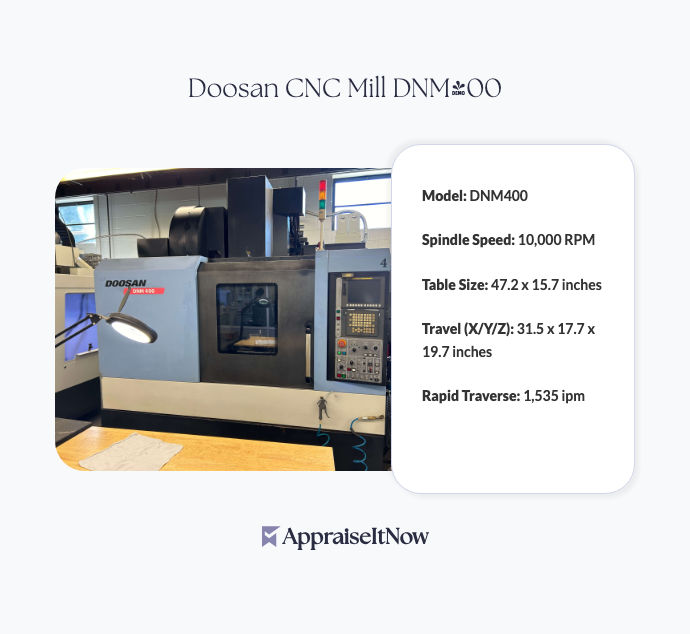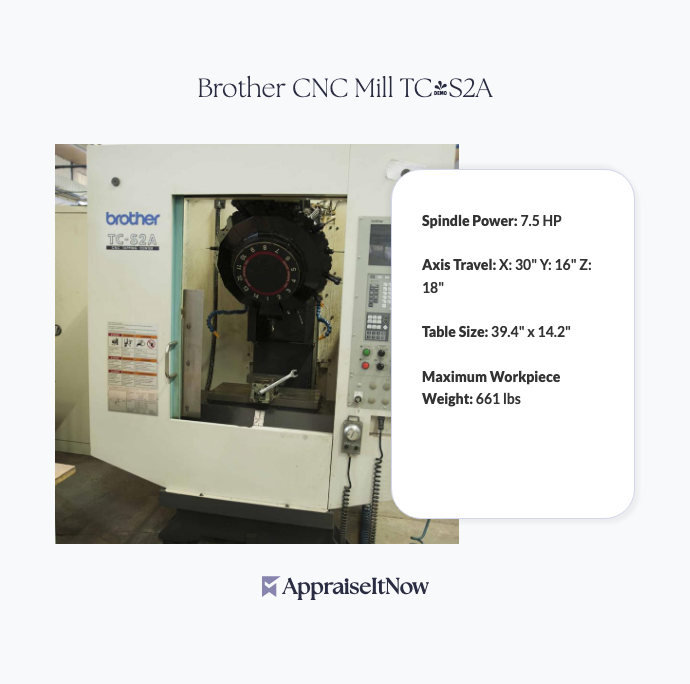<h1>How to Get Your Hardinge CNC Lathe Conquest Appraised</h1>
<p>The Hardinge CNC Lathe Conquest represents a significant capital asset in precision manufacturing, with current market estimates ranging from <strong>$150,000 to $160,000</strong> for well-maintained examples. Whether you're evaluating this machine for sale, insurance purposes, or financial reporting, understanding what drives its valuation and how to navigate the appraisal process ensures you capture accurate market value.</p>
<h2>Why Your Hardinge CNC Lathe Conquest Matters</h2>
<p>First introduced in 1990, the Hardinge Conquest established itself as a cornerstone machine in precision engineering workshops, tool and die shops, and aerospace and automotive manufacturing facilities. The machine's reputation stems from its Hardinge-designed spindle and slideways, coupled with a proprietary thermal management system that ensures consistent thermal stability—critical for maintaining tolerances in complex parts manufacturing.</p>
<p>When evaluating precision machinery like your Conquest, you're assessing far more than just a tool. This is a specialized asset that directly impacts your production capabilities. The question of <em>how much is a used CNC machine worth</em> depends largely on several interconnected factors that professional appraisers understand deeply. Understanding these dynamics helps you position your machine appropriately in today's <a href="/types/equipment-and-machinery">equipment and machinery</a> market.</p>
<div class="callout tip"><p><strong>Valuation Insight</strong></p>
<p>Hardinge CNC machines with documented maintenance records and original Hardinge-specified components typically command 15-20% premiums over machines with aftermarket modifications.</p></div>
<h2>Key Specifications That Drive Appraisal Value</h2>
<p>Your Conquest's value reflects its advanced engineering and proven reliability. The machine features rugged cast iron construction designed for durability, an advanced CNC control system with programmable tool paths, and precision ground components tuned for optimal performance. These technical specifications directly influence how appraisers evaluate your machine.</p>
<p>The Conquest's compatibility with a wide range of tooling systems represents significant value—it means your machine can adapt to diverse production requirements without requiring specialized fixtures or conversion kits. This versatility matters because it expands the potential buyer pool and production applications, both of which appraisers consider when establishing fair market value.</p>
<p>Precision spindle speeds and intelligent thermal management ensure the machine produces consistent, high-quality outputs that meet demanding industry standards. The significance here is practical: a machine that maintains tolerances reliably is worth substantially more than one requiring frequent recalibration or thermal compensation adjustments.</p>
<h2>Condition and Operational History</h2>
<p>The typical lifespan of a CNC lathe extends well beyond 20-30 years when properly maintained, though operational intensity and maintenance protocols significantly affect remaining useful life. Your Conquest's age since introduction in 1990 means many examples are now entering their fourth decade of service, making condition assessment absolutely critical to appraisal accuracy.</p>
<p>Professional appraisers examine several condition indicators when evaluating <a href="/types/metalworking-equipment">metalworking equipment</a>. They assess spindle runout precision, thermal stability under load, and the mechanical responsiveness of all moving components. Documentation of preventive maintenance becomes exceptionally valuable here—machines with detailed service records, regular spindle bearing replacement schedules, and thermal calibration logs command substantially higher valuations than machines with incomplete history.</p>
<p>The question of <em>how much does it cost to run a CNC machine per hour</em> connects directly to your machine's condition and value. A Conquest operating efficiently within manufacturer specifications might consume 8-12 kilowatts per hour, while one with spindle bearing wear or thermal compensation issues might consume 15+ kilowatts as it compensates for performance drift. This operational cost differential becomes factored into residual value calculations.</p>
<h2>Market Demand and Industry Applications</h2>
<p>Understanding <em>what is the difference between a CNC lathe and a lathe</em> helps clarify why your Hardinge Conquest occupies a premium market position. While manual lathes require operator skill to maintain tolerances, CNC machines like the Conquest hold repeatable tolerances automatically through programmed instructions. This capability transforms the machine from a skill-dependent tool into a production-quantity device, dramatically expanding its market appeal and residual value.</p>
<p>The aerospace and automotive industries represent your machine's core market, where precision requirements demand exactly the repeatability the Conquest delivers. Medical device manufacturers and precision component makers also represent significant demand pools. This broad application base means your Conquest likely has multiple qualified buyer categories, which appraisers factor into market demand assessments.</p>
<div class="callout note"><p><strong>Market Context</strong></p>
<p>Hardinge machines manufactured between 1990 and 2010 are currently experiencing renewed interest from shops modernizing their equipment without replacing entire production lines, supporting stable or appreciating values for well-maintained examples.</p></div>
<h2>Documentation Requirements for Accurate Appraisal</h2>
<p>Preparing your Hardinge CNC Lathe Conquest for professional appraisal requires specific documentation. Our guide on <a href="/blog/what-documents-do-you-need-for-a-metalworking-equipment-appraisal">what documents are needed for equipment and machinery appraisal</a> provides comprehensive detail, but the essentials include original purchase documentation, maintenance records, any factory service bulletins or upgrades performed, and manufacturing serial number verification.</p>
<p>Current CNC control system functionality matters significantly to appraisers. If your Conquest runs legacy Hardinge CNC software, documentation that the system still operates reliably—or conversion documentation if the control was upgraded to modern FANUC or Siemens platforms—provides critical context for value determination. Modern control conversions sometimes enhance machine value by extending operational lifespan, though original specification machines may command premiums among collectors of classic manufacturing equipment.</p>
<p>Physical documentation through high-resolution photographs of the machine from multiple angles, including close-ups of any identifying nameplates and serial numbers, helps appraisers verify authenticity and assess visual condition. This photographic record becomes particularly valuable for insurance purposes or when circumstances prevent in-person inspection.</p>
<h2>Understanding the Appraisal Purpose</h2>
<p>Your reason for seeking an appraisal determines the specific valuation approach and reporting requirements. If you're evaluating your Hardinge for sale, fair market value estimates guide pricing strategy. Insurance valuations typically aim for replacement cost estimates, which may differ from fair market value depending on current inventory availability. Financial reporting, equipment financing, or estate settlement purposes each carry specific valuation methodologies that professional appraisers adjust accordingly.</p>
<p>Exploring how <a href="/blog/how-does-metalworking-equipment-appraisal-impact-your-tax-status">equipment and machinery appraisal impacts your tax status</a> reveals important considerations for business owners. Proper appraisal documentation supports depreciation calculations, asset write-downs, and equipment disposition valuations that tax professionals require. The appraisal becomes part of your financial record-keeping that substantiates tax positions during audits.</p>
<h2>Comparative Market Analysis</h2>
<p>When appraisers evaluate your Hardinge CNC Lathe Conquest, they analyze comparable machines recently sold or currently listed in the marketplace. This comparative analysis examines similar model years, comparable spindle capabilities, equivalent control systems, and machines demonstrating similar production capacity. Regional variations significantly affect these comparisons—Conquests in active manufacturing regions with dense user communities may command different premiums than machines in areas with fewer precision shops.</p>
<p>The broader question of <em>how much is a lathe worth</em> has no single answer because lathe values span an enormous range based on type, size, precision capability, and condition. Your Conquest, as a precision CNC instrument, occupies the premium segment. Manual lathes might value in the $5,000-$15,000 range depending on size and condition, while your Hardinge's advanced capabilities and precision push it into a substantially higher category reflecting its production contributions and technical sophistication.</p>
<h2>Final Assessment and Next Steps</h2>
<p>Your Hardinge CNC Lathe Conquest represents a significant manufacturing asset deserving professional valuation expertise. Whether you're preparing for a potential sale, updating insurance coverage, or managing financial records, a certified appraisal from experienced professionals provides the documentation and market analysis that protects your interests. Our team of credentialed appraisers specializing in <a href="/types/heavy-machinery">heavy machinery</a> and <a href="/blog/appraising-industrial-equipment-assessing-machinery-and-manufacturing-assets">industrial equipment</a> understand the nuanced factors affecting Hardinge machine valuations and can deliver USPAP-compliant reports suitable for any purpose.</p>
<div class="callout note"><p><strong>Key Takeaway</strong></p>
<p>A professional appraisal of your Hardinge CNC Lathe Conquest provides accurate market valuation ($150,000-$160,000 range), comprehensive documentation for insurance and financial purposes, and confidence that you understand your machine's true worth in today's manufacturing equipment market.</p></div>







.avif)







